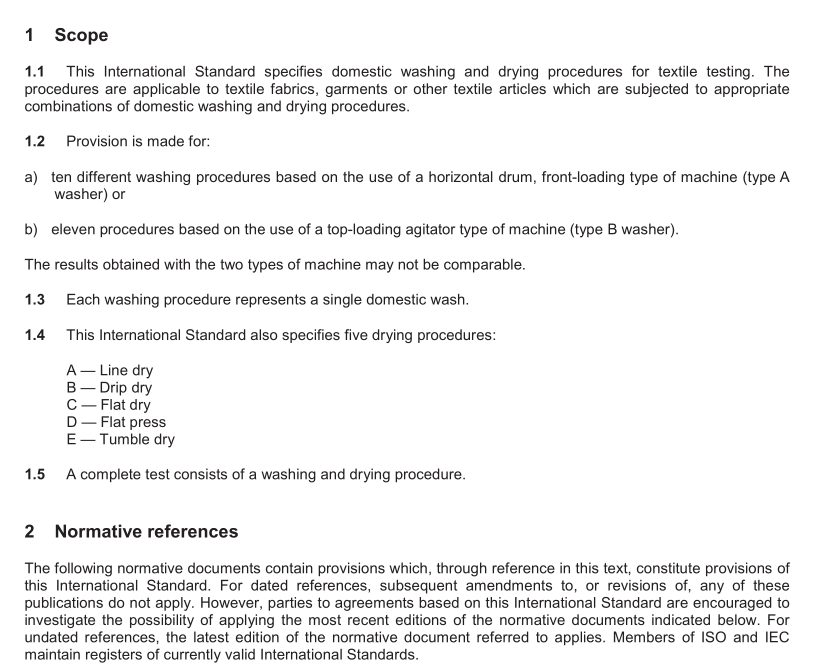AS 2001.5.4 pdf download – RECONFIRMATION OF AS 2001.5.4—2005 Methods of test for textiles Method 5.4: Dimensional change—Domestic washing and drying procedures for textile testing (ISO 6330:2000, MOD)

AS 2001.5.4 pdf download – RECONFIRMATION OF AS 2001.5.4—2005 Methods of test for textiles Method 5.4: Dimensional change—Domestic washing and drying procedures for textile testing (ISO 6330:2000, MOD)
5.4Electrically (dry heated) heated flat-bed press. f this method of drying is used, the type of press shall bespecified between the interested parties.
5.5Facilities for line drying (see 8.1) or drip drying (see 8.2).
5.6Screen drying racks of approximately 16 mesh stainless steel or plastic (see 8.3).
6Test specimens
The number of specimens to be subjected to the washing and drying procedures specified in this InternationalStandard will be determined by the purpose for which the material is being tested.
7 Washing procedure
7.1Select the washing procedure to be used from those given in Table 1 for a front-loading type of machine orfrom Table 2 for a top-loading type of machine.
7.2Weigh the (individual) specimens or made-up articles (8.2) or garments (8.5) before washing if they are to betumble dried.
7.3 Place the material to be washed in the washing machine (see 5.1.1 or 5.1.2) and add sufficient ballast (see5.3) to make a totalai-dry material load of the mass shown for the washing procedure selected. if dimensionalstability is being determined, not more than half of the wash load shall consist of test specimens.Add sufficientdetergent (4.1.i to 4.1.3,as appropriate) to provide a good running suds having a height of not more than(3主0,5) cm at the end of the washing cycle.
Before placing the test load to be washed in type B washers, ill the machine with water at the selectedtemperature, add(66 ± 1)g 1993 AATCC Standard Reference Detergent or the appropriate amount of lEC or ECEdetergent, to provide good running suds having a height of not more than (3 ±0,5) cm at the end of the washingcycle.
7.4 After the hydroextraction of the washing procedure has been completed, remove the material, taking carethat it is neither stretched nor distorted, and dry it by one of the drying procedures described in clause 8.
7.5lf the material is to be drip dried,stop the machine just before the final hydroextraction and remove thematerial, taking care that it is neither stretched nor distorted.
8Drying procedure
8.1Procedure A – Line dry
Suspend the hydroextracted material from a line to dry according to the procedure specified in 8.2.
8.2Procedure B- Drip dry
Remove the material from the machine and, without extracting the water, suspend it from a line in still air at roomtemperature and allow to dry.
The warp or wale direction of the material shall be vertical, Made-up articles shall be suspended in the direction ofuse.
8.3Procedure c – Flat dry
Spread out the material on a horizontal screen drying rack (see 5.6), remove the wrinkles by hand withoutstretching or distorting, and allow it to dry.
8.4 Procedure D— Flat press
Place the material on the flat bed of the press (see 5.4). Smooth out heavy wrinkles by hand and lower the head ofthe press, which shall be set at a temperature suitable for the material to be pressed, for one or more short periodsas required to dry the material. Record the temperature and pressure used.
8.5Procedure E- Tumble dry
NOTE This procedure is not intended to be used for evaluating articles containing temperature sensitive fibres.Research ison-going to establish the appropriate criteria for these fabrics.
At the end of the selected washing and hydroextraction process, immediately place the material and the ballast inthe tumble dryer (see 5.2).Tumble dry the load as follows.
lf measuring the fabric temperature during tumble drying is required, plastic ribbons (thermolabels) that indicate thetemperature, shall be affixed to the fabric. These thermolabels shall be capable of measuring in the temperaturerange (40 to 9o) °c.
To determine the optimum heat setting, tumble dry the load at the normal (high) heat setting for the calculated testcycle time as determined by the method described in annex C.At the end of the calculated test cycle time the finalmoisture shall be equivalent to the moisture content of the conditioned textile (0 % at 20 °C and 65 “C relativehumidity).
lf a weighing device is used, place the tumble dryer on the platform of the weighing device and determine the massof the dryer. Place the weighed specimens or garments including ballast in the dryer and switch on the dryer.Continue drying until the mass does not change and then switch off the heat and allow to run without heat for atleast 5 min.After this time, measure the mass of the relaxed specimens or garments.
Determine the dimensions of the materials and then proceed to further dry the load until the final moisture shall beeither – 2 % for synthetics or -5 % for cellulosics.
Dry to constant mass.
For machines specified in 5.2.2, ensure that the temperature of the exhaust from the drum is set at a temperaturenot exceeding 70 “C for normal fabrics and 50 °C for permanent press or delicate fabrics. Operate the dryer untilthe load is dry, and continue tumbling for 5 min with the heat turned off.Remove the material immediately.









